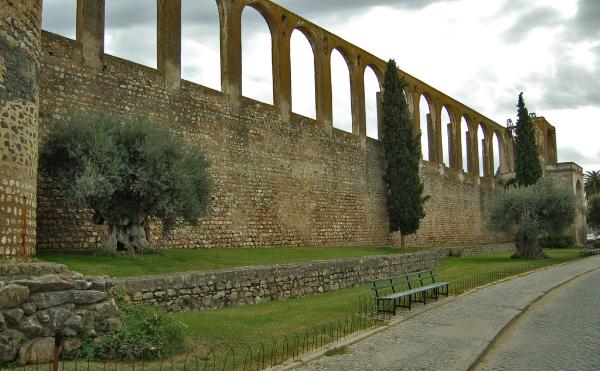Há muito, muito tempo, existia uma terra na parte mais ocidental da
Europa conhecida pela terra das serpentes. Nessa altura, existia
uma charneca onde as suas terras e da sua vizinhança eram do
domínio de uma serpente alada, forte e vigorosa, que parecia
conseguir deitar lume pelas ventas e vivia acoitada nas fragas de
um rio conhecido pelo Rio Anas. Assim que a serpente sentisse que o
seu território, a charneca, estava em perigo ela se aprestava para
vir em socorro das suas terras e defendia-as, vitoriosamente, de
quem viesse para lhes fazer mal. Muito deve ter lutado essa
serpente para defender esta terra que agora se chama Serpa e o seu
rio Guadi-Anas Guadiana. Certo é que Serpa sobreviveu a todos os
perigos e no seu brasão possui a Serpe a recordar a sua guardiã e
dos seus habitantes, os serpentinos.
 |
As Muralhas de Serpa inseridas no meio de um outeiro, estão
presentes estilos de arquitectura militares e civis. Esta
fortificação que esteve sob o jugo muçulmano, já existia desde os
tempos de ocupação romana, tendo sido conquistada por D. Afonso
Henriques, em 1166, ficando novamente mais tarde sob o domínio
árabe. Meio século depois, D. Sancho II, em 1232, expulsou
definitivamente os árabes de Serpa. Esta fortificação traduzia-se
por uma forte muralha torreada e um poderoso castelo, que conseguiu
resistir às guerras pela independência, que ocorreram entre os
séculos XIV e XVII. Primeiramente reconstruídas por D. Dinis, com o
aproveitamento de parte da alcáçova existente, sofreu nova
intervenção seiscentista. Actualmente, é composta pelo castelo e
alcáçova com torre de menagem adossada, e muralhas reforçadas por
torres e torreões. Dentro e fora das muralhas estende-se a
povoação, a maior parte da qual ainda intramuros. O Palácio dos
Melos está assente sobre um de seus panos, assim como o aqueduto,
cuja arcada se prolonga até à nora mourisca, que servia para
abastecer de água o Palácio. |
|
A long time ago, there was a land in the western part of Europe
known for land of snakes. At that time, there was a heath where
their land and their neighborhood were the domain of a snake with
wings, strong and vigorous, who seemed able to throw fire by its
noses and lived hidden in the rocks of the river known as Rio Anas.
Once the snake feel that their territory, the heath, was in danger
it get’s set to come in aid of their land and defend it,
victoriously, who would do harm to them. This snake (serpente in
portuguese) should have fought a lot to defend this land that now
called Serpa and the river Guadi–Anas, Guadiana. It’s true that
Serpa survived all dangers and its crest has a female snake (serpe
in Portuguese) to recall its guardian and its inhabitants, the
Serpentinos (name of habitants of Serpa; In New York they are New
Yorkers, in Serpa they are Serpentinos).
 |
The defender walls of Serpa are inserted in the middle of a small
hill. There are present military and civilian architecture styles.
This fortress that was under the yoke Muslim, existed since the
time of Roman occupation, and was won by D. Afonso Henriques (first
Portuguese King), in 1166, leaving, later again, by the Arab
occupation. Half a century later, D. Sancho II (fourth Portuguese
King), in 1232, permanently expelled the Arabs from Serpa. The
resulted fortification is a strong wall with towers and a powerful
castle, which managed to resist the independence war, occurred
between the centuries XIV and XVII. First rebuilt by D. Dinis
(sixth Portuguese King), using the existing main fortress, suffered
further intervention in sixteen century. Today, it is composed by
the castle and the main fortress with the principal tower next to
it. The walls are reinforced by towers and towers. Inside and
outside the walls lies the village, most of which still inside the
fortress walls. The Palace of Melos is based on one of its panels,
as well as the aqueduct, which extends to the arcade is Moorish
water pump, which served to supply water to the
Palace. |